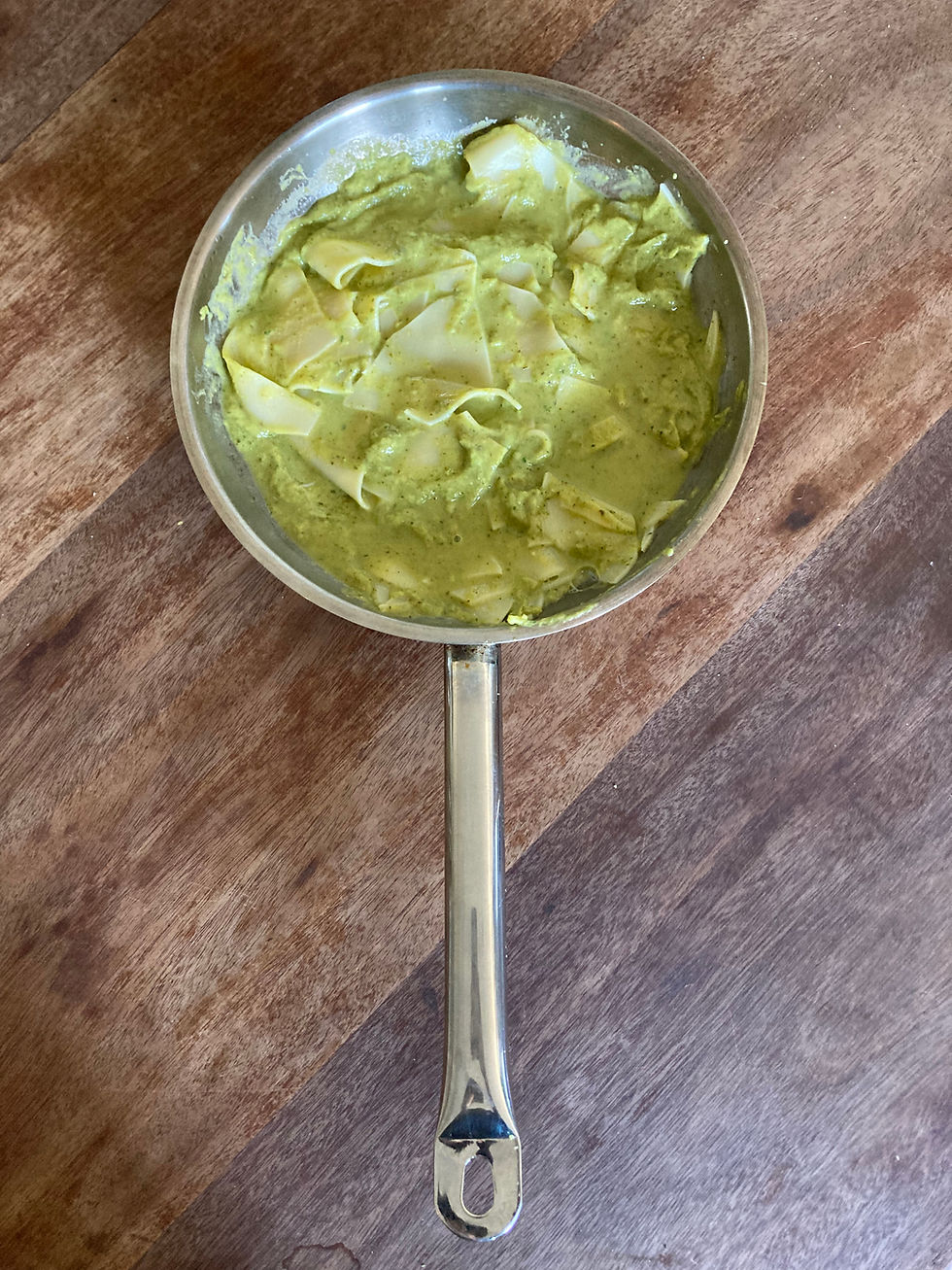Easy Green Lasagne Recipe
- Shannon Devy

- Nov 22, 2024
- 3 min read
Lasagne was one of the first dishes I taught myself to cook from a Jamie Oliver lasagne recipe in a dingy student digs on Lower Main Road in 2016. It's a great comfort food for a Trump election, so I thought I'd revive it eight years later — this time with a few twists.
Traditional lasagne calls for the laborious layering of cooked mince, lasagne sheets, and béchamel sauce. But this cheat's lasagne simply requires tossing semi-cooked lasagne shards into a prepared sauce and topping the entire thing off with parcels of molten, bubbling, golden-brown mozzarella. It's low-effort but chic, like Shane McCutcheon or a white vest and a ciggie. Very brat, to use Collins' word of the year.

There's nothing wrong with the classic combination of beef mince and tomato sauce, but I love a green vegetable for summer pasta dishes. This combination of peas, baby marrow, and white beans is lighter than traditional lasagne fillings but still packs a protein punch.
What you'll need from the shops to make this cheat's green lasagne recipe
Lasagne sheets (preferably the ones that do require pre-cooking; otherwise, fresh pasta would do fantastically)
Punnet of baby marrows
Fresh herbs of choice — I used parsley
About six cloves of garlic
Frozen peas
Tin of cannellini or butter beans
Fresh lime
Olive oil
Mozzarella — fior di latte adds a lovely texture, but any kind will do

How to make cheat's green lasagne
Step One: Prep your kak
The sauce comes together quickly for this recipe and most of the effort is tied up in cooking the baby marrow. Peel your garlic and bring about a centimetre of olive oil to frying temperature on medium heat in a Dutch oven or similar.
Meanwhile, evenly slice your marrow, pat dry, and fry in batches with the garlic cloves until everything is lightly browned and still soft. Once cooked, you can remove from the oil and lightly salt the lot.

Once that palaver's over, bring a large pot of salted water to the boil on the stove and preheat the oven to 200 degrees Celcius with the grill on. Optional: reserve some marrow medallions for a garnish.
Step Two: Prepare the pasta
Unfortunately, most grocery stores stock lasagne sheets that don't require pre-cooking. That is unideal for our purposes, as the sauce doesn't stay in the oven long enough to cook the pasta, but boiling it can cause the shards to stick to each other.

My advice? Either make pasta from scratch, buy lasagne sheets that require pre-cooking, or take care to boil the pasta in plenty of hot water while stirring frequently to prevent sticking.
If you are using store-bought pasta, break the sheets into shards before cooking as picture above. Rustic is the vibe, but do aim for pieces that are roughly the same size. Cook until al dente. Remember to reserve the pasta water.

Step Three: Prepare the green sauce
A tabletop blender works best to achieve a smooth, silky sauce, but this can be achieved with a stick blender. The sauce should be adjusted to your taste, but here are the rough measurements I used:
A whole punnet of cooked marrow
About a cup of frozen peas
A fistful of parsley
Plenty of pasta water, added gradually
Zest and juice of half a lime
First, shock your herbs by submerging them in boiling water before plopping them into an ice bath. Tip the shocked herbs, frozen peas, lime juice, zest, and cooked marrow into the blender with a splash of pasta water and blend until combined. You can always add more pasta water later, so a thick sauce is preferable to a thin one.

Step Four: Combine pasta and sauce
In a shallow ovenproof dish (I used a stainless steel pan), combine the cooked pasta shards with the sauce. You may need to loosen the sauce with more pasta water.

Step Five: Top with cheese
Break the fior di latte into pieces and nestle them into the cooked pasta. Top with grated parmesan if you've got it.

Shove the entire thing into the hot oven and leave it until the cheese is bubbling. Be wary of overcooking your sauce and dehydrating the lasagne — 10-15 minutes should do the trick.
Step Six: Serve and enjoy
Once the cheese has melted, simply scoop a serving or two and tuck in. Creamy, cheesy, savoury, packed with vegetables. Not much more you can ask of a pasta dish, really.





This gorgeous Easy Green Lasagne Recipe caught my attention as I was scrolling through my feed for a hearty weekend dinner idea. It looks so colourful and delectable, and I love that it's loaded with greens! Making it for my family is already something I can picture. Speaking of future planning, ever since I received my degree, I have been thinking a lot about my career. It felt overwhelming until, happily, I discovered the highest paying jobs with a legal studies degree service; it provided the much-needed clarity by seamlessly connecting my education to real, high-value career paths that I hadn't even given much thought to.